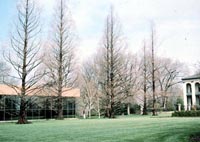Resource Library
Plant of the Week: Dawn Redwood
The University of Arkansas System Division of Agriculture does not promote, support or recommend plants featured in "Plant of the Week." Please consult your local Extension office for plants suitable for your region.
Plant of the Week
Dawn Redwood
Latin: Metasequoia glyptostroboides

With only a limited amount of room in our gardens, it makes sense to use plants that
have multiple seasons of interest or at least a good story to tell. The dawn redwood
is one of the trees that has a good story to tell, and it’s a good story dating back
over 60 million years ago.
Dawn redwood has the distinction of first having been noticed as a part of the fossil
record in 1855. The fossils were first thought to be those of our native bald cypress,
but just weeks before the bombing at Pearl Harbor, a Japanese scientist noticed that
the fossils did not match any known tree so he reclassified the fossil plant under
a new name, Metasequoia.
Fossil records of dawn redwood have been discovered in Japan, western North America
and Greenland, indicating that it – like the ginkgo – once was very widely distributed.
The dawn redwood is a deciduous conifer similar to bald cypress. It grows up to 100
feet tall with a narrow, pyramidal form while young, and a large, swollen trunk. The
leaves are feathery, light green and soft textured. Being a conifer it does not have
showy flowers. Seeds on adult trees are produced in a cone.
Tsang Wang, a forester employed by the National Central University in China, happened
upon an unusual tree in 1941 growing between rice paddies in the Shuishaba Valley
in south-central China on the Sichuan and Hubei Provencal border.
The locals called the tree water pine and used its wood for cabinet making. He collected
pressed specimens of the foliage and sent them to Beijing where, in the fall of 1946,
they were finally associated with the fossil records and the tree was identified as
a living fossil.
Perhaps finding a living fossil plant is not as exciting as finding a living dinosaur,
but it’s still pretty big news and word of the discovery quickly was received in Boston
at Harvard’s Arnold Arboretum.
During the next growing season, Tsang, supported by funds from the Arnold Arboretum
and accompanied by Ralph Chaney a paleobotanist from the University of California,
flew to the valley to collect seeds just before the Bamboo Curtain came down and sealed
off China for the next 35 years.
Four pounds of seeds were collected, despite a government ban, and sent back to the
Arnold Arboretum for distribution. In subsequent years the area was explored more
thoroughly and about 1,000 trees were found in the valley with an elevation of 3,400
feet. The area received about 50 inches of rainfall a year.
Today, the trees in the valley are protected by the Chinese government, but during
the Cultural Revolution several of the largest trees were cut.
The dawn redwood makes a fast growing specimen tree in the landscape, attaining 25
feet in height in 10 years. It should be planted in sites with good soil that can
be irrigated during dry spells. Unlike its look-alike cousin, the bald cypress, dawn
redwood will not tolerate dry sites.
By: Gerald Klingaman, retired
Extension Horticulturist - Ornamentals
Extension News - March 5, 1999
The University of Arkansas System Division of Agriculture does not maintain lists of retail outlets where these plants can be purchased. Please check your local nursery or other retail outlets to ask about the availability of these plants for your growing area.